
Photo credits: iStockphoto.com/blackdovfx
Media Revenue Optimisation (but not only) will become critical to survive and thrive in the 2020s
Era of transformation for (D)OOH
If you work in the (D)OOH industry you know that the world started to change at a faster pace over the past decade.
- Technology disrupted habits and media consumption (online, mobile, digital, etc.)
- Data inspired advertisers to improve their ROI, wanting their campaigns to be always more tailor-made and efficient
- Programmatic inspired entrepreneurs and shareholders to optimise their businesses
- And last but not least Digital OOH brought new standards (selling per hour, by slot in the loop or share of time), new rules (programmatic) and new possibilities (flexibility, data, creativity, etc.) to advertisers, buyers and sellers
Naturally, it began with a lot of talking and it took some time until this really started happening in advanced markets. But all these major changes are happening simultaneously!
The community also got bigger: more companies, more screens, more events, more associations, and more changes at a global scale (FEPE becoming WOO for instance).
Dynamic assets and value (Revenue Management)
As Digital OOH was being implemented, people started wondering how they should price their assets. They could always extrapolate from OOH or compare to other media (online, radio, TV), but in reality they were blindfolded since DOOH (and its sales practices) is unlike anything else.
It divided the world of media owners into two groups:
- Some oversold as their prices were too low at first.
- But most failed to sell their entire inventory because their offers and pricing did not match market demand, and ended up overestimating their sales force.
Anyway, pricing is not about immediately getting the price right; it’s about adapting over time. That is done by monitoring revenue, pricing and demand across different analytics in order to find trends and opportunities. But also by being able to seize them by adapting offers and pricing all year long. Where you start doesn’t matter that much as long as you can adjust dynamically.
If you want to look at your inventory in a analytical but simple way, it looks like this:
- On the Y axis is the pricing level
- On the X axis is the ramp-up fill rate (which represents the % of assets you sold over time)
- The red zones are opportunities that media owners should seize (by order of potential gain).
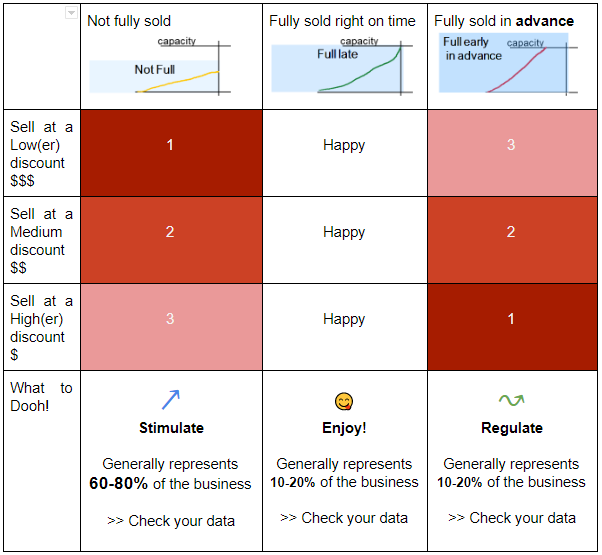
The first cell of the table (up, left) represents the part of the offer that wasn’t fully sold and for which no pricing effort was made (low discount). And yes, that often exists as people are afraid to lower their prices because they don’t know how to raise them again later (but that’s possible of course if you do it the right way). The positive dynamic of DOOH created new players, increased the number of available screens and thus created a wider offer and a generally lowly filled inventory for media owners (a big part of the available airtime on screens would not be sold).
On the contrary, the last cell (down, right) represents the part of the inventory that was sold early in advance with high discounts. And again, this is often seen as sales teams’ bonuses are often (always) based on volumes, so the first thing they do is sell the easiest things to sell. It makes sense but not profit.
The last line shows the current state of the “sell out” with the share of assets in each column and says what has to be done to optimise revenue on these situations. Of course the numbers are correct if you look at a company’s inventory on a global level. It is the Revenue Management’s job to dive in, identify opportunities and inform the organisation to do so (marketing, sales, planning).
Also the figures are true for (D)OOH now and they will evolve when consolidation happens and the medium reaches to seize its full potential. But if you follow the Pareto principle (the 80-20 rule) the main goal is clear today, in one word: Stimulate!
This leads us to a common misconception about Revenue Management: that it only consists of managing fully sold assets with pricing techniques (the “Regulate” column). This is indeed a tricky part of the job which requires the ability to forecast future demand and qualify it in terms of revenue. But in fact Revenue Management represents a larger spectrum of actions that aim to optimise revenue on all assets and periods by order of priority depending on where the potential is. Adapting the offer dynamically to stimulate the market with flexible and fenced pricing policies (to avoid cannibalisation) is a stake that RM tackles. This is often put aside as it has deeper implications on sales processes and IT systems (booking, planning and business analytics), but this is also where the greater value is.
Mise en abîme (Covid-19)
Strangely enough this industry acceleration happened at a particular moment, when globalisation reached its peak point and when Covid hit businesses and put the world on hold for a while.
Now we are at the edge, all together facing what the US army would call a VUCA (Volatile Uncertain Complex Ambiguous) future. With lots of questions… and not many answers, as depicted by the IAB below.
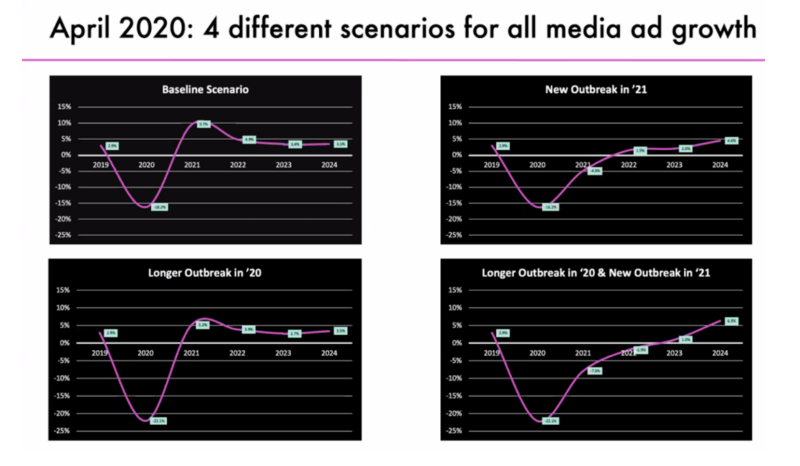
The only sure things are that we don’t know what tomorrow will bring, and that optimisation has never been more important to survive and thrive as a company.
The post-Covid era, unlike anything else we’ve seen, makes us face boundaries, fear, excitement, risks and opportunities — ingredients that announce a ruthless battle for share to come in the media landscape! The ability to adapt the offer, take rapid business decisions and carry out those decisions will become critical.
Covid-19 emphasised the importance of generating and catching demand, in two words it made it: Stimulate².
Datagrammatic salvation
Data and programmatic are the two cornerstones to stimulate the media market and transform the industry.
- Data attracts advertisers (from other media or from competitors without data).
- Programmatic significantly reduces costs on both ends, gives the opportunity to update content on the fly, and thus attracts ‘programmatic buyers’ with their BIG budgets.
They will allow the DOOH market to develop, making it a larger and tastier pie.
But that won’t be enough, as both data and programmatic deeply transform the nature of the business and tend to make it more rational, scientific and efficient, but also way more complex to understand and manage.
Sell complexity…
Sorting out the future from a sales standpoint is a true headache. It won’t be achieved with under-optimised processes and so many questions to answer every other day. Before (Covid) products were generally built every year to answer general needs observed on the market. They were then listed and available on Powerpoints and Excel spreadsheets. Then buyers (led by agencies or specialists) asked for tailor-made and bespoke deals as they got data. And this is where the headache started. Then came loops, share of time, audience measurement, cost per mille, etc.
In the datagrammatic world we are now talking about managing granular assets and sales that don’t fit in a spreadsheet. Even a small DOOH company which has 100 digital screens sold by slot (let’s say only 6 slots per hour) would have: 100 * 24 * 6 * 365 = 5,256,000 products to sell per year! Of course you can package them, but not only once a year. And the way you package becomes strategic.
With Covid-19 every media company had to reshuffle and rethink their offer for Q3 and Q4 2020. So many companies (if not all) spend a terrific amount of time managing their sales and fixing their planning in the backstage. They navigate between different tools, spreadsheets and emails to serve clients and tell the market that they are “datagrammatic compliant”.
To do so they have to hire talented people who quickly get overwhelmed, or more people to sell more. But does that really work? It is hard to hire more and better when the economy is hit hard.
… in a complex world
Many companies won’t be able to bear these costs anymore, and the game will become trickier every year. The good news is that the current situation is driving everyone towards innovation in order to survive and thrive. The challenge in this particular time will be to optimise on both ends by spending less time on ineffective or unintelligent tasks, to focus on generating more deals on the other hand.
The thing is, we are all already doing that — right?
Descartes’ error
We all believe that we are rational, and even more when the situation gets complex. Part of the reason are our cognitive biases (there is an amazing list of them on Wikipedia), in other words our difficulty to be open to the unknown, to better listen and integrate emotions as part of the decision making process. Not doing so has us stuck in the past.
What happened with Covid-19 is a good example to illustrate how we behave individually and collectively when things are new and complex. The first data that the global health community gathered about Covid 19 in January immediately revealed an exponential growth of the number of cases. Exponential growth was hard to believe even by scientists because the numbers were still small and that it had never happened in their lifetimes (climate change may be the same thing, just bigger…).
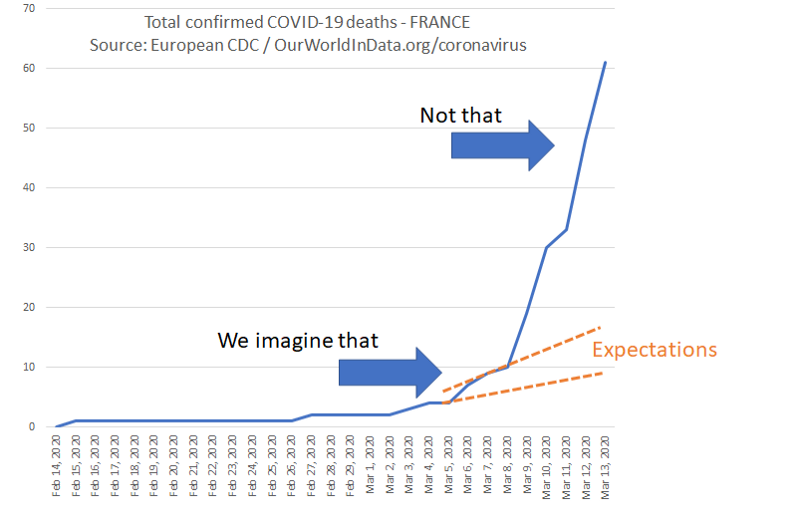
Hard to blame them as we had a global cognitive bias orgy at the time. You could hear and read pretty much everything. Some overestimated risks, some thought it was only a “chinese thing”, or that maybe “crazy europeans” could get it but not “civilized people” 
Personally, I must admit that when the lockdown started in Italy I still doubted (I could not believe it) that it would happen in France. That was seven days before I ended up locked at home for 2 months. Ridiculous, right?
The thing is that figures don’t lie (except when they are wrong or voluntarily tampered with, but that’s a topic for another time). In that period statistics were the most reliable source of information to understand and decide at a global level.
My point here is that media owners need the same thing to drive change in their sales in a VUCA world: statistics.
Clever machines at your service (and not the contrary)
The other good news is that only us, humans, are able to truly innovate.
Machines can automate and learn as much as they want, they will only make it easier to manage data and better replicate what happened in the past (which is already big). They can’t invent something that didn’t really exist before. They don’t know how to learn by observing the future because they have no feelings, intuition and only one brain (did you know we have 3?). They are too rational (sorry guys).
Self-learning machines learn from what we feed them, which is “past” data. We tell them how to observe, calculate, decide or act. Everything else is pure science-fiction (which can be fun by the way :)).
The most powerful computer paired to the smartest algorithm on the planet won’t be able to tell you what to do to face Covid-19 as a company. They can help us understand but then more than anything else we will need guts, hearts and our good old-fashioned human brains.
What machines are doing far better than us is manipulating data and learning from the past in a purely scientific and powerful fashion, without any sentiment.
They can help us manage, aggregate and display information to show the patterns and better understand the complex world we live in.
Update the framework
Statistics have the power to reveal clear patterns from a complex phenomenon. They help us understand the world by giving factual information we can rely on collectively.
The etymology of the word complex reminds us to embrace and plait the elements when it gets complex. In other words, to connect deeply to what we do, to how we do it, and to whom we do it with. I believe that we will need to update a large part of the way we work in order to develop collective intelligence (topic for a future article). And the way digital tools are conceived is going to be key to do so on a large scale.
Conceiving an IT system is kind of like designing architecture and urbanism. You create a framework with the purpose of creating spaces to ease relationships and life within it to develop (creativity, curiosity, calm, intelligence, playfulness, etc.). This is how you get to like (or not) a house, a city or any type of building, organisation or software.
And this is why I think media owners should really care about the way they are going to design their future systems and select their tools.
Concretely
In more practical terms and reflecting on the situation here is what I think media owners should consider when designing their future sales systems and strategies.
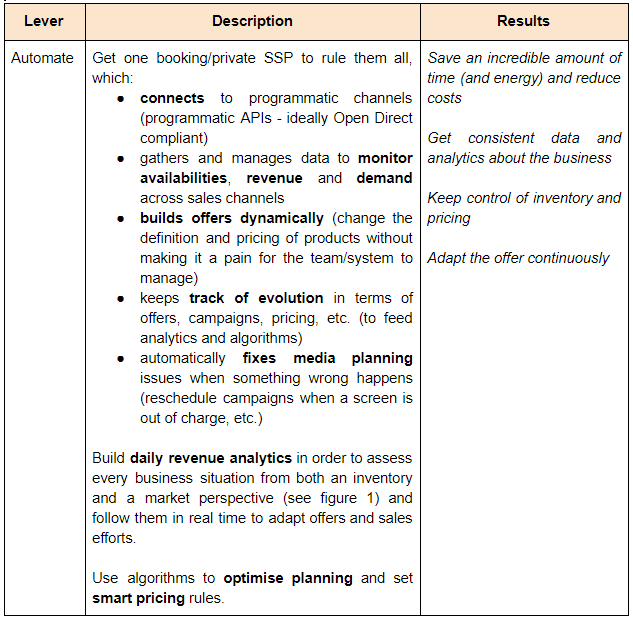
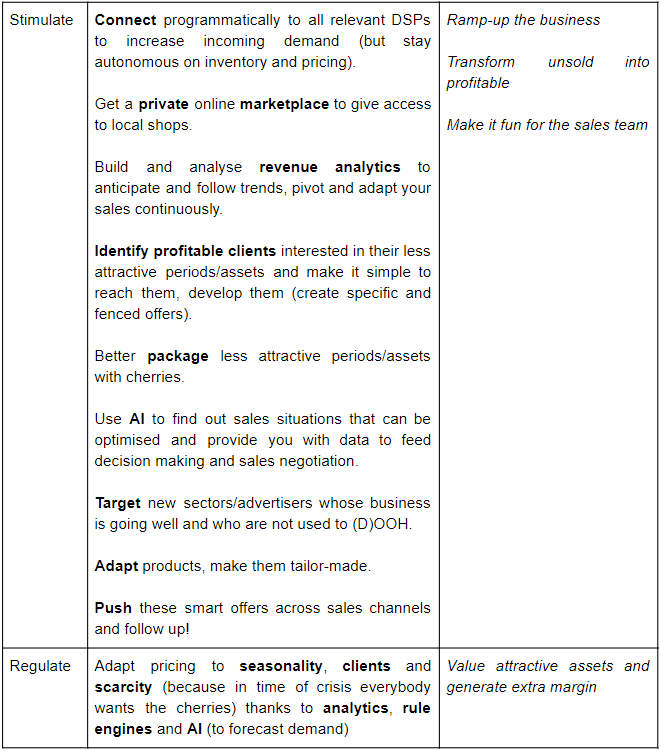
Conclusion
In a complex and transforming world, it is critical to design the right architecture to pilot sales. Optimisation has to happen all along the way and fit with people, processes,cultureandrules to be sustainable. It has to serve a creative process which makes it fun to make progress and change.
Companies are spending a lot of time and effort and enormous sums of money to do so. Many fail because it is hard, because it concerns almost the entire organisation and because it requires to break silos (or just open the doors). And maybe because they often forget the fun part of it, the creativity that it requires and the pleasure we can get from being creative.
Other industries and companies have had to do so. The ones that embraced the change and transformed their purposes and missions succeeded (profit only doesn’t drive change anymore).
Philosophy and vision are the roots of collective evolution. When they are shared they create frameworks and cultures effortlessly.
Revenue management and sustainable optimisation (but also deliberately developmental organisations – topic for an upcoming article) are business philosophies that will help companies survive and thrive in the 2020s.